In a way, project management is as old as human civilization — from organizing farm work and managing grain stockpiles to executing massive construction projects, our ancestors had to find some way to manage their resources and achieve their desired end result.
The modern idea of project management, however, dates back to the 20th century, and the world as we know it couldn’t exist without it. As such, the importance of project management cannot be overstated.
In this article, we’ll introduce you to the fundamentals of project management, starting with some basic definitions. Then, we’ll define projects, followed by a closer look at some popular project management methodologies, and the 3 pillars of project management.
Finally, we’ll provide some useful tips, consider the benefits of project management, and take a look at an illustrative project management example at the end.

What is project management in simple terms?
In simple terms, project management is the application of skills, tools, and techniques to project activities in order to meet project requirements.
Project management definitions
And now, let’s provide a more comprehensive definition of project management.
The 7th edition of the Guide to the Project Management Body of Knowledge (PMBOK), provides the following definition of project management: “The application of knowledge, skills, tools, and techniques to project activities to meet project requirements.”
The Association of Project Management (APM) defines project management as “the application of processes, methods, skills, knowledge, and experience to achieve specific project objectives according to the project acceptance criteria within agreed parameters.”
According to APM, a key factor distinguishing project management from just “management” is that it has a final deliverable and a finite timespan, whereas management is an ongoing process.
In Project Management: A Systems Approach to Planning, Scheduling, and Controlling, Harold Kerzner defines project management as “planning, organizing, directing, and controlling of company resources for a relatively short-term objective that has been established to complete specific goals and objectives.”
As we can see, all these definitions are very similar — they all involve meeting project requirements as an ultimate goal.
💡 Plaky Pro Tip
Project management is often confused with some similar terms, and their meanings sometimes overlap. To see how project management compares to other kinds of management, check out the following guides:
What is a project?
To better understand project management, we should also define the term “project.”
If we look at PMBOK’s definition of a project, it’s described as “a temporary endeavor undertaken to create a unique product, service, or result.”
Another similar definition comes from the above-mentioned APM article, which defines a project as a transient endeavor meant to achieve planned objectives, further defined by its outputs, outcomes, and benefits.
Harold Kerzner, in his 10th edition of Project Management, A Systems Approach to Planning, Scheduling, and Controlling, defines a project as “any series of activities and tasks that:
- Have a specific objective to be completed within certain specifications,
- Have defined start and end dates,
- Have funding limits (if applicable),
- Consume human and nonhuman resources (i.e., money, people, equipment), and
- Are multifunctional (i.e., cut across several functional lines).“
What are the characteristics of projects?
On the above-mentioned page, The Project Management Institute pointed out several characteristics common for all projects:
- All projects are unique.
- All projects are temporary.
- All projects have a team.
- All projects have a budget.
- All projects have a schedule and expectations the team needs to meet.
Let’s explain these characteristics in more detail.
#1 All projects are unique
Projects bring new value to an existing entity or create something completely new.
For example, developing a website or creating a new application for online shopping are examples of unique projects. Redesigning said website or app is also a unique project, as the new website won’t have the same design or functionality as the old one.
While some projects — particularly repeated ones — might not seem unique at a glance, they all have a definite end point and will inevitably differ on some level throughout different iterations.
#2 All projects are temporary
“Temporary” doesn’t mean that projects last for a short period of time. It means that every project lasts for a limited time and has a definite beginning and end, regardless of whether it’s successful or not.
As for the exact timeframe of a given project, it can vary greatly depending on the specifics — a project can take anywhere from a few hours to several years to complete.
💡 Plaky Pro Tip
It doesn’t matter how long they take — managing a surge of new projects isn’t easy! Luckily, we’ve got 3 tips to help you succeed:
#3 All projects have a team
No project is a 1-man job. So, every project has a team, and a project team consists of members from various disciplines who share a common goal — to complete the project successfully.
#4 All projects have a project budget
No matter how big or small the project is, it cannot be executed without appropriate funding. As such, a project manager must always carefully consider the project budget.
As the Australian Institute of Project Management pointed out in their ultimate guide to project budgets, “if you under-call the budget, you’ll end up missing milestones, being under-staffed, and having to do the walk of shame to the finance department to ask for more money.”
#5 All projects have a schedule and expectations the team needs to meet
A project schedule is a listing of project activities, milestones, and deliverables. It also determines the start and end dates of a project, its duration, and resources assigned to each activity.
What are clearly defined projects?
Clearly defined projects are projects whose goals and objectives meet the SMART criteria. The acronym SMART stands for Specific, Measurable, Attainable, Relevant, and Time-based.
A project goal provides direction, while project objectives are specific targets the project aims to achieve to meet the goal. Every project has multiple project objectives.
Going by the acronym, they should be:
- Specific — the objective is clearly defined.
- Measurable — relevant metrics are used to determine when the objective is met.
- Attainable — the team concurs the objective is realistic.
- Relevant — the objective fits the organization’s strategic plan and supports the project charter.
- Time-based — there is a precise date by which the objective should be achieved.
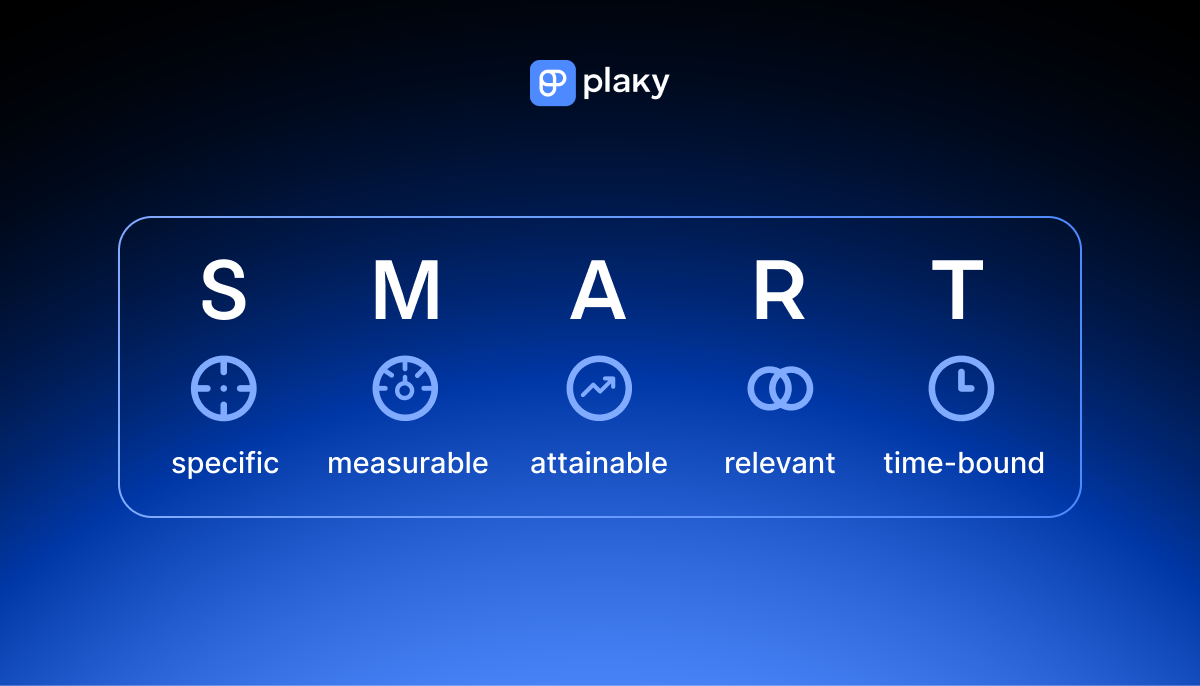
Now, you might be wondering how this looks in practice. Let’s provide an example of SMART goals for project objectives.
If you are a project manager in a software development company and your company is developing a new website for a client, your SMART objective may look like this:
Change the current back-end tasks priority by assigning new due dates to all 5 critical tasks over the next three days without changing the original project deadline, so we can demonstrate a demo website version to our client on January 20.
Let’s break down the SMART criteria for this example:
- Specific: Change the current back-end tasks priority
- Measurable: by assigning new due dates to all five critical tasks
- Attainable: over the next three days
- Relevant: without changing the original deadline
- Time-based: so we can demonstrate a demo website version to our client on January 20.
What are some project examples?
Now that we’ve gone over the definitions, characteristics, and a SMART project example, here are some more concrete examples of projects:
- Development of a new product or service: a new website, online shop, etc.
- Creation of a new information system: an online airline ticket booking system, a customer relationship system, etc.
- Construction of a building or industrial plant.
- Improvement of existing business procedures: implementing a new company wiki, onboarding or recruitment process, customer support procedures, etc.
💡 Plaky Pro Tip
Learn how to start a project in just a few steps in the guide below:
A quick history of project management
As mentioned before, project management has been a part of our lives since the very first organized human activities.
For instance, thousands of people had to cooperate to build world wonders such as the pyramids in Egypt, Machu Picchu in Peru, and the Great Wall of China. These massive undertakings had to be planned and coordinated until they were completed successfully.
However, modern project management dates back to the early 20th century.
Henri Fayol and Henry Gantt are considered to be forefathers of the project management concept, as they established the foundation of project management and expanded it in all fields.
Henri Fayol is famous for defining the 5 functions of management:
- Planning,
- Organizing,
- Commanding,
- Coordinating, and
- Controlling.
Henry Gantt is well-known for popularizing the Gantt chart as a project management tool around 1910 — though it was Karol Adamiecki, a Polish engineer, management researcher, economist, and professor, who invented this type of tool in 1896.
Over the course of the 20th century, these ideas were built upon, leading to the founding of many professional organizations and the development of new project management methodologies.
However, it’s difficult to see an end point for project management, as it is always changing and adapting to new conditions.
The most recent example of this is the rise of virtual project management, with many new tools and techniques that have emerged to bring project management into the new era of remote and hybrid work.
💡 Plaky Pro Tip
Learn more about the history of project management — and enjoy a few chuckles — in the meme-powered overview below:
What are the core components of project management?
Projects differentiate from everyday business activities and require employees to come together for a limited time to focus on specific objectives.
According to the above-mentioned article from the Association of Project Management, the core components of project management include:
- Determining the reason a project is needed,
- Understanding project requirements,
- Estimating time and resources,
- Defining the quality of project deliverables,
- Analyzing costs and benefits to justify the investment,
- Securing project funding,
- Developing and implementing a project management plan,
- Leading the project team,
- Managing the project’s risks and problems while staying on top of changes,
- Monitoring projects process and managing the allocated budget,
- Managing suppliers, and
- Closing the project.
💡 Plaky Pro Tip
For great books you can read to build up (or brush up on) your project management knowledge, you can refer to this guide:
Who uses project management?
We can implement project management in all industries and businesses. Some industry examples include:
- IT,
- Construction,
- Transportation,
- Infrastructure,
- Product manufacturing,
- Finance, and
- Law.
What are the different types of project management?
Many project management methodologies have been developed over the years, but some have naturally been more prominent and influential than others.
In this section, we’ll briefly go over some popular project management methodologies, including:
- Waterfall,
- Agile,
- Scrum,
- Kanban, and
- Lean.
#1 Waterfall
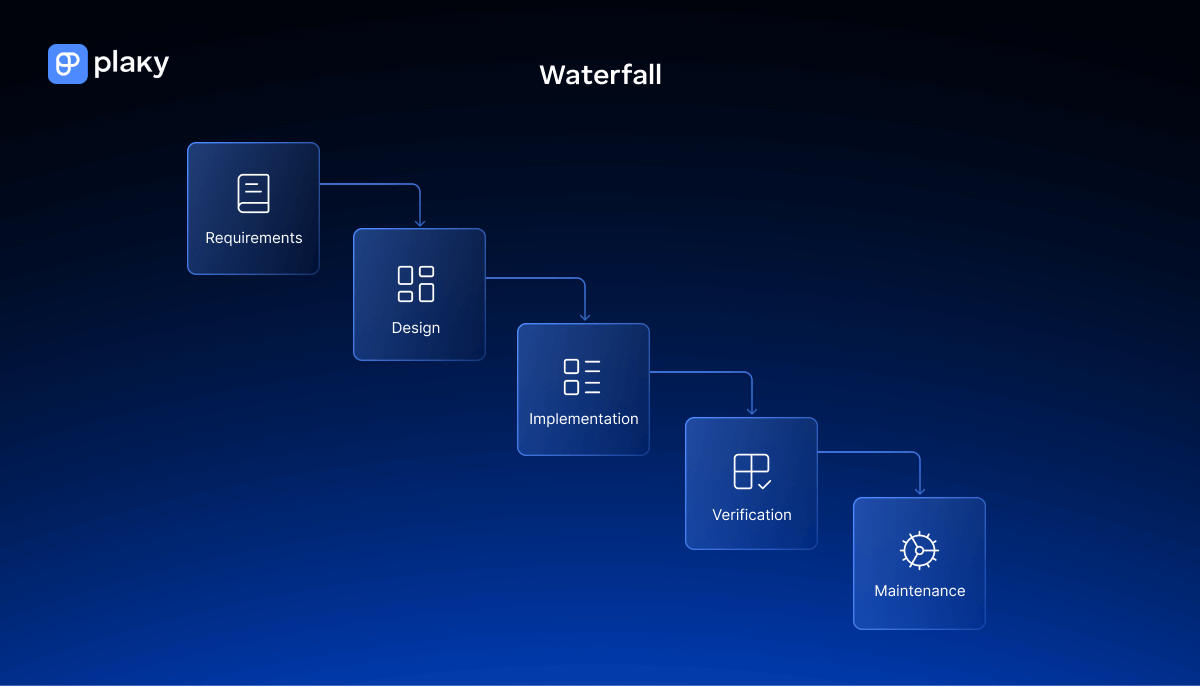
The Waterfall methodology relies on careful planning and execution of projects through several consecutive phases, with each phase leading over into the next — hence the name “waterfall.”
These phases are usually divided into:
- Requirements — acquiring and analyzing client requirements,
- Design — planning the individual phases and the project as a whole,
- Implementation — putting the plan into practice,
- Verification — ensuring that all requirements are met, and
- Maintenance — implementing ongoing changes to ensure a product’s continued success and viability.
At its core, Waterfall project management is all about thorough planning and precise execution. This makes it a safe and reliable methodology, especially for large and expensive projects.
On the other hand, this also makes it rigid and inflexible, putting a lot of pressure on the initial planning stages to anticipate possible complications. Ultimately, this makes error correction more expensive, and the reliance on consecutive phases also means it’s not the most time-efficient approach.
💡 Plaky Pro Tip
If you’re interested in reading more about the Waterfall methodology, take a look at our full article on the subject:
#2 Agile
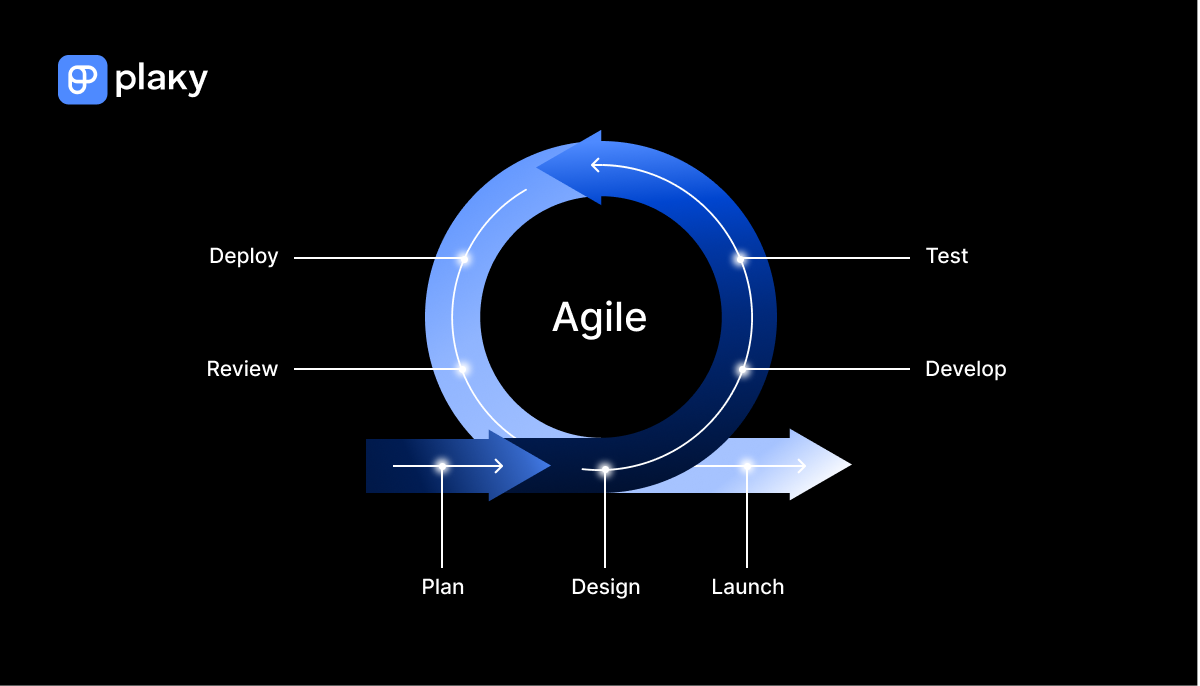
Standing in stark contrast to Waterfall, the Agile approach is all about maximizing flexibility and adapting to changing situations, rather than strictly following a plan laid out in advance.
Originally meant for use in software development, this methodology has now been adopted across many industries due to its:
- Adaptability,
- Increased customer satisfaction, and
- Effective use of resources.
However, the Agile approach also relies heavily on customer interaction, which can detract from its overall efficiency.
Furthermore, the lesser focus on planning can lead to many unpredicted costs that, while not necessarily high at face value, can add up over the course of a project.
💡 Plaky Pro Tip
If you’re interested in reading more about Agile, take a look at our full article on the subject:
#3 Scrum
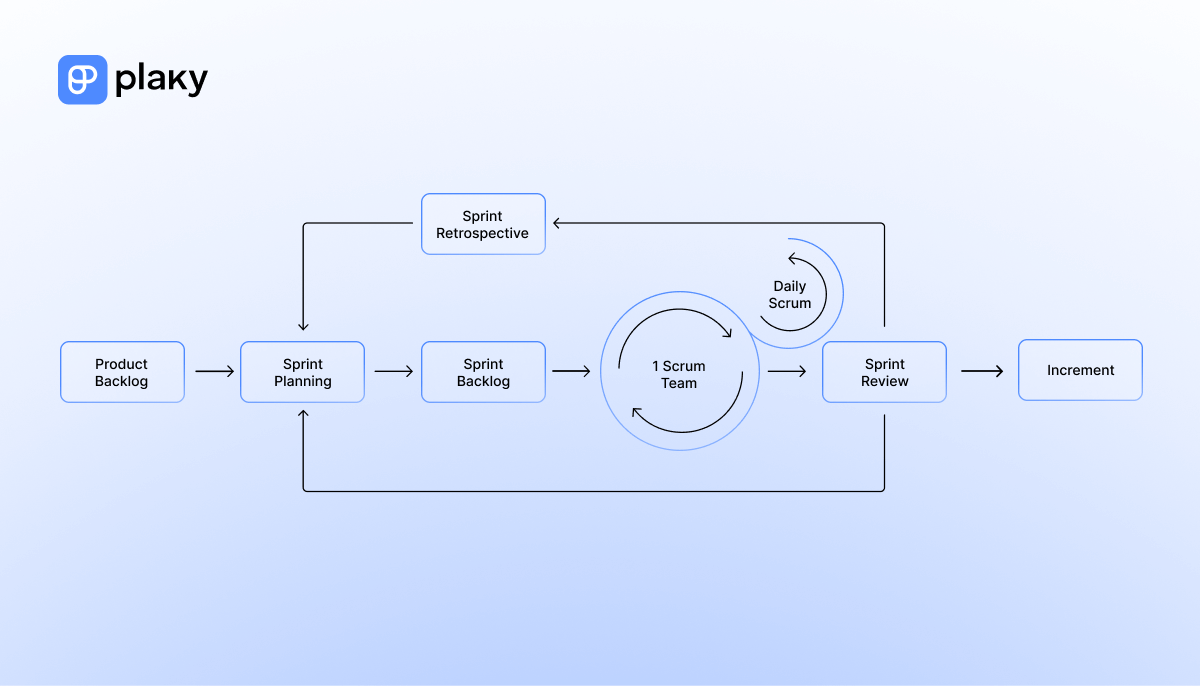
Scrum is a popular project management framework built on Agile principles. It was introduced in the early 1990s and remains one of the most widely used methodologies to this day.
Scrum is focused on delivering value and optimizing processes, defined mainly by Sprints. In this context, a Sprint is a circular process focused on completing a set of tasks within a given time period. Once a Sprint is complete, the team moves on to another one.
Scrum is great at:
- Maintaining steady progress,
- Breaking down complex projects into smaller segments,
- Enhancing team communication, and
- Encouraging a result-oriented mentality in the team.
However, Scrum is also among the more difficult frameworks to implement effectively, as it creates a dynamic and intensive environment that requires an experienced team capable of working under pressure.
Furthermore, Scrum is also more reliant on planning, so it’s not a good fit for projects that involve lots of unknowns and don’t have a defined project roadmap.
💡 Plaky Pro Tip
If you’re interested in reading more about Scrum, take a look at our full article on the subject:
#4 Kanban
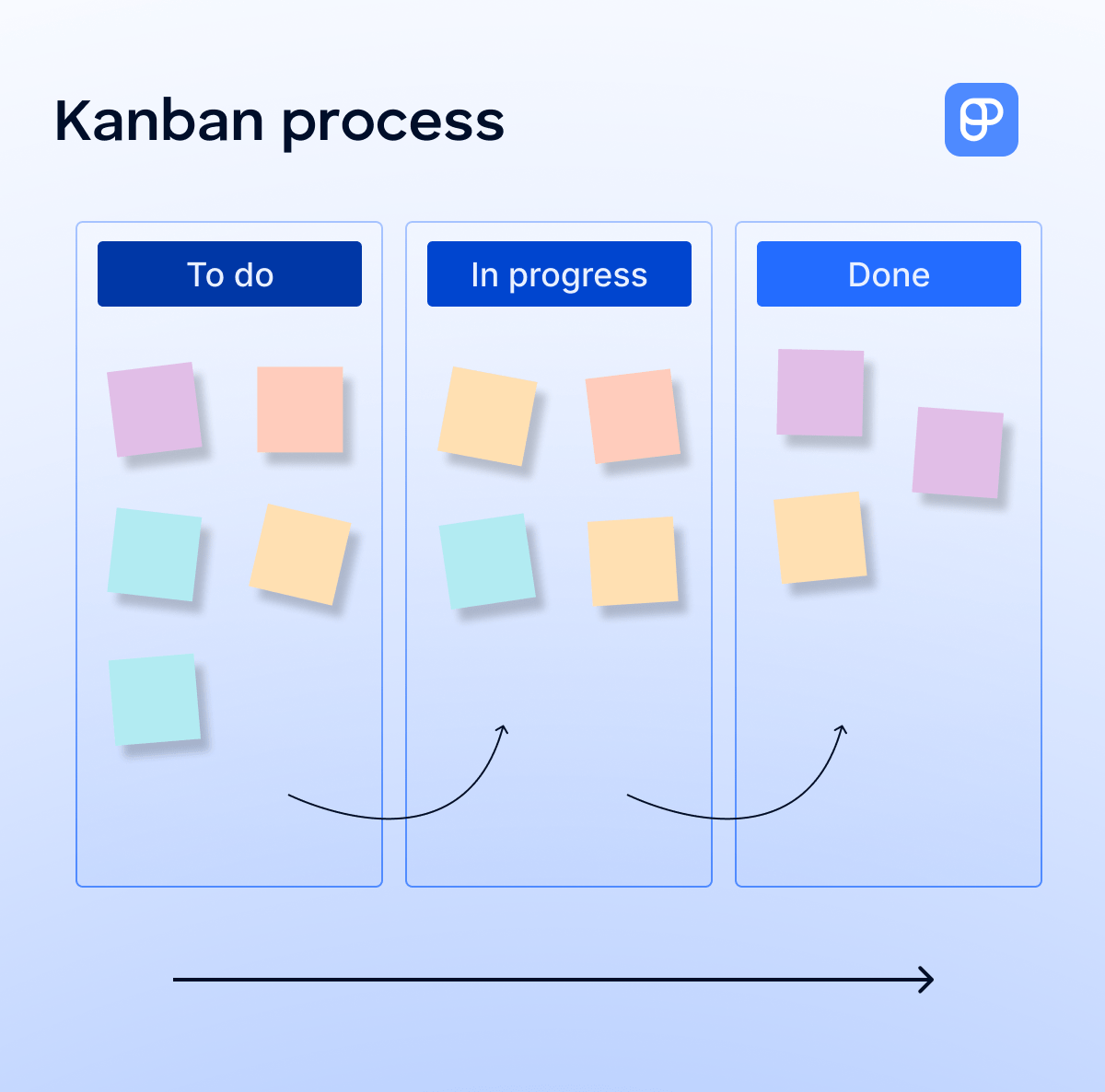
Developed in the 1940s by the Toyota engineer Taiichi Ohno, Kanban remains one of the simplest and most popular project management methodologies to this day.
The main goal of Kanban is to help visualize the workflow and ensure efficient work distribution, which is done through the Kanban board.
The board contains task cards with all the information relevant to a particular task, which are in turn organized into columns, such as:
- To do,
- In progress, and
- Done.
Of course, project managers can introduce additional columns, depending on the specifics of the project.
Overall, Kanban is great for:
- Streamlining workflows,
- Enhancing collaboration between teammates, and
- Improving overall efficiency.
On the downside, Kanban is heavily focused on sequential workflows, so it’s not an ideal fit for dynamic projects that might require the team to respond to changing situations or frequently move tasks back and forth between columns.
💡 Plaky Pro Tip
If you’re interested in reading more about Kanban or the unique mix of Kanban and Scrum — Scrumban — take a look at the articles below:
#5 Lean
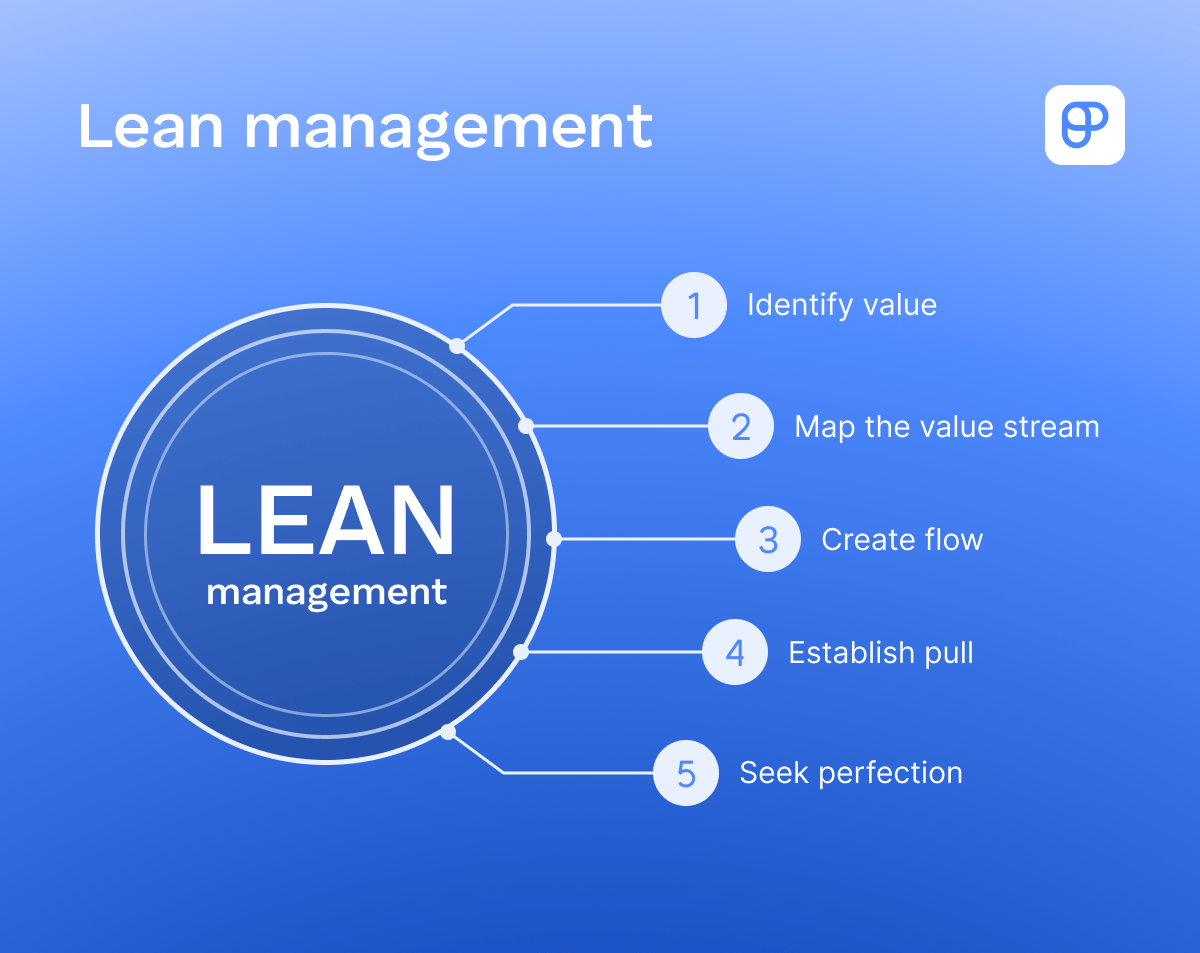
Lean project management focuses on maximizing resource efficiency in order to minimize resource waste and maximize profit margins.
As such, it is highly focused on detailed planning and is built around 5 core principles:
- Identify value,
- Map the value stream,
- Create flow,
- Establish pull, and
- Seek perfection.
That said, Lean excels at minimizing costs and improving customer satisfaction — delivering the best product possible at the lowest possible cost.
However, due to its focus on optimizing resources, it also doesn’t leave much room for error. Any mistakes can negatively affect the production process or risk delivering a subpar product.
💡 Plaky Pro Tip
If you wish to read more about the Lean methodology or some of the other project management methodologies we haven’t covered here, take a look at the articles below:
What are the 3 pillars of project management?
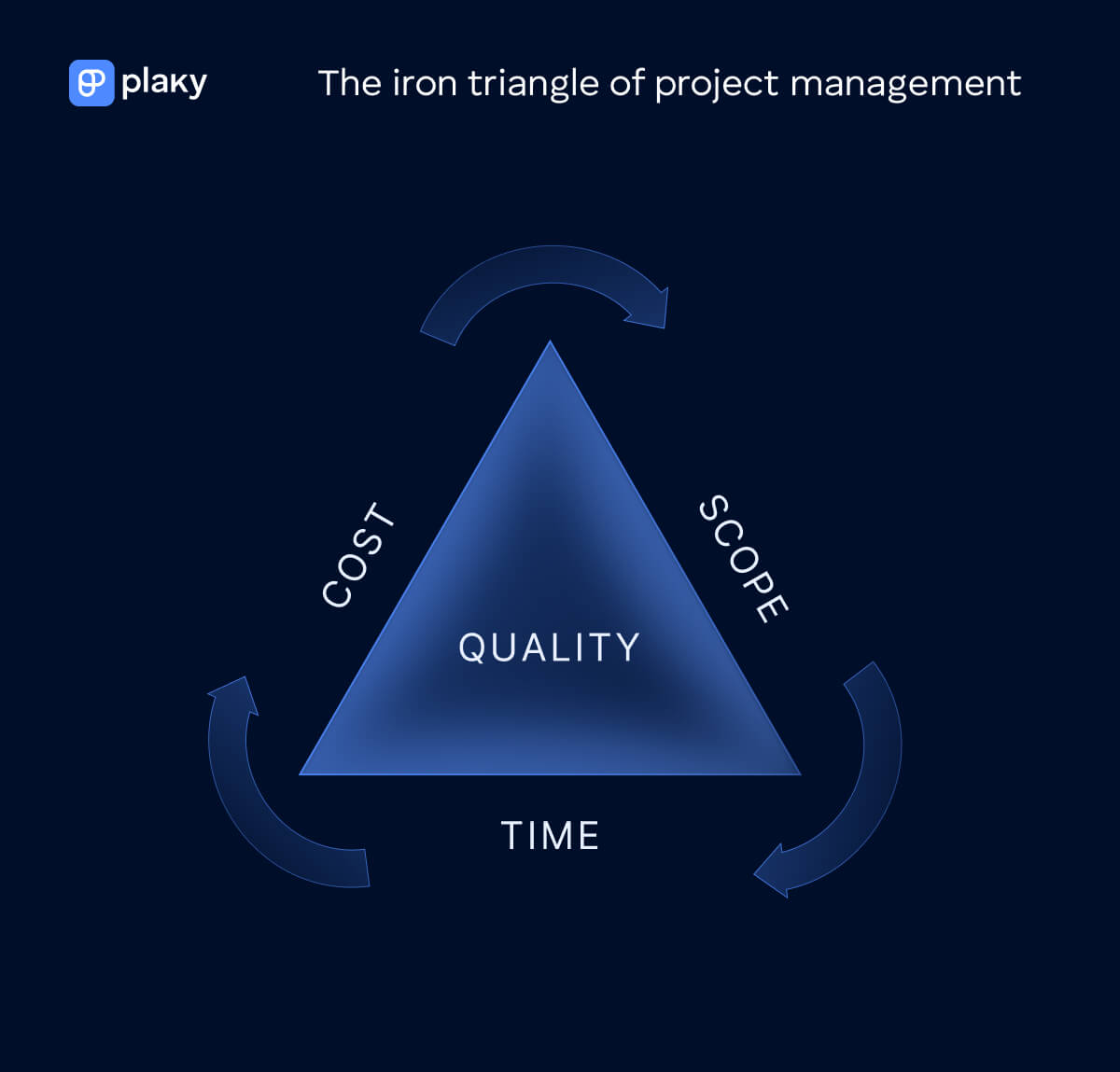
Every project comes with limitations and risks that project managers need to address to ensure success. The project constraints that project managers always deal with, irrespective of their industry, include:
- Scope,
- Time, and
- Cost.
These constraints are limitations placed upon the project that the project manager and his team must work within. They are often referred to as the project management triangle and the triple constraints.
This model of the constraints of project management has been used since at least the 1950s. Basically, they are a set of 3 interdependent project constraints that every manager faces.
Let’s take a look at each one more closely.
#1 Scope
The scope constraint refers to what must be done to deliver the project’s end result. This constraint defines specific deliverables and the tasks needed to meet the project goal.
#2 Time
The time constraint refers to the time available to complete project tasks — and the project itself. It is also called a schedule and includes the deadlines for project phases, all the major project milestones, and the date for the delivery of the project outcome.
#3 Cost
The cost constraint refers to the budget available for the project: employees and equipment costs, as well as the cost of other resources needed for the project.
Every project manager needs to balance these 3 constraints to deliver the best results. And each of these constraints is connected with the other two.
For instance, increasing a project’s scope will likely require more time and money. On the other hand, accelerating the timeline for the project may cut costs and diminish the scope.
💡 Plaky Pro Tip
For more tips on how to master project management, check out the blog post we have on the subject:
📖 Project management is a vast and sometimes complicated topic, where some words take completely new meanings. If some of the terms used in this guide are confusing if, you might want to check out our Project Management Glossary of Terms and further explore basic and advanced project management terminology.
How to manage projects
Are you thinking about implementing project management processes at your company or simply considering ways to optimize your current approach?
Here’s a short project management guide with some useful tips:
- Maintain open and clear communication,
- Set clear, achievable goals,
- Carefully consider the team’s workload,
- Pay attention to time management,
- Minimize multitasking,
- Anticipate setbacks,
- Do your research and pick the right methodology, and
- Pick a good project management tool.
Now, let’s explain these in a bit more detail.
Tip #1: Maintain open and clear communication
As most experienced project managers will agree, efficient communication is the cornerstone of effective project management, regardless of industry or methodology.
To achieve success, it’s crucial to communicate requirements and deliverables to the team clearly, from the project as a whole down to individual tasks. Open communication is also vital when it comes to adapting to changing situations, which every project will inevitably encounter.
However, maintaining communication is more than simply communicating the bare necessities — it’s about developing a culture of trust in your team, thus ensuring everyone is comfortable voicing their thoughts, opinions, and concerns.
According to the latest communication statistics for 2023, as many as 31% of businesses rely on email for internal communication, which is far less efficient than using a specialized communication app.
💡 Plaky Pro Tip
Want to learn more about the importance of communication in project management? Take a look at the following article:
Tip #2: Set clear and achievable goals
As we’ve previously mentioned, every project has an end point — a particular objective or goal. And in order to execute a successful project, you have to determine what that goal is.
Above all else, it’s important for this goal to be achievable and realistic with regard to the team’s resources, capacities, and timeframe.
Furthermore, having a specific goal in mind is good for team morale, as everyone knows what they’re working towards and where their daily efforts ultimately lead.
Tip #3: Carefully consider your team’s workload
Stress has always been a problem in the workplace, and it only seems to be getting worse — as many as 77% of Americans have experienced burnout. And if you wish to optimize productivity for the long term and avoid this issue, it’s important to consider each team member’s workload.
Efficient workload management is good for morale and goes a long way to ensuring long-term commitment, as well as quality in an employee’s deliverables.
In contrast, a stressed and overworked employee is more likely to make mistakes or actively look for other work opportunities, which can potentially lead to a domino effect. Team members leaving is never good for morale, and the reduced capacity either means a temporary setback for the project or more work for other team members.
Tip #4: Pay attention to time management
Time management is right up there with communication when it comes to executing projects efficiently and in a timely manner.
To meet the final deadline set by a stakeholder or client, internal deadlines must be met, and doing so will require careful planning and the implementation of some time management strategies.
Furthermore, good time management also requires you to use the right tool for the job. In this case, it would be a time-tracking app such as Clockify, which would also allow you to track productivity and scheduling more efficiently.
💡 Plaky Pro Tip
Looking to learn more about time management in regard to projects? Here’s a useful article you should read:
Tip #5: Minimize multitasking
Though it is a popular term in project management circles and unavoidable to a certain degree, multitasking is not good for productivity.
In fact, research from the American Psychological Association has shown that multitasking can reduce productivity by as much as 40%.
As such, it’s best to avoid interruptions or juggling between tasks since it can lower overall productivity and create more room for errors to occur.
Instead, make sure your team members have clear goals they have to achieve, as it will help improve focus and, by extension, productivity.
Tip #6: Anticipate setbacks
Risk and unforeseen setbacks are a constant threat to any project. It’s important to always plan for potential interruptions to the workflow so that you can adapt and keep the project going with minimal setbacks.
This can include anything from delayed supply shipments and power outages to an important team member having to take a sick day and leaving a crucial task with lots of dependencies unfinished.
Risk management is difficult, and it’s impossible to plan for everything. However, so long as you consider your project roadmap carefully and identify the weak points, you should be able to minimize any damage caused by unforeseen complications.
Tip #7: Do your research and pick the right methodology
As we’ve already mentioned, project management has branched out into a wide array of different methodologies, all of which have their own unique strengths and weaknesses.
That said, there is no single optimal way to manage projects, and the key is finding the methodology that suits your needs best. This could be one of the methodologies we’ve listed, or it could even be a hybrid project management approach that combines elements from multiple methodologies.
Tip #8: Pick a good project management tool
You should always use the best tool for the job, and that involves the project management process itself.
Today, there are dozens of specialized project management tools to choose from, and they can greatly facilitate the manager’s job, streamline work for everyone, improve time management, and much more.
Project management software is a slightly more complex subject, so we’ll go over it in more detail below.
What is project management software?
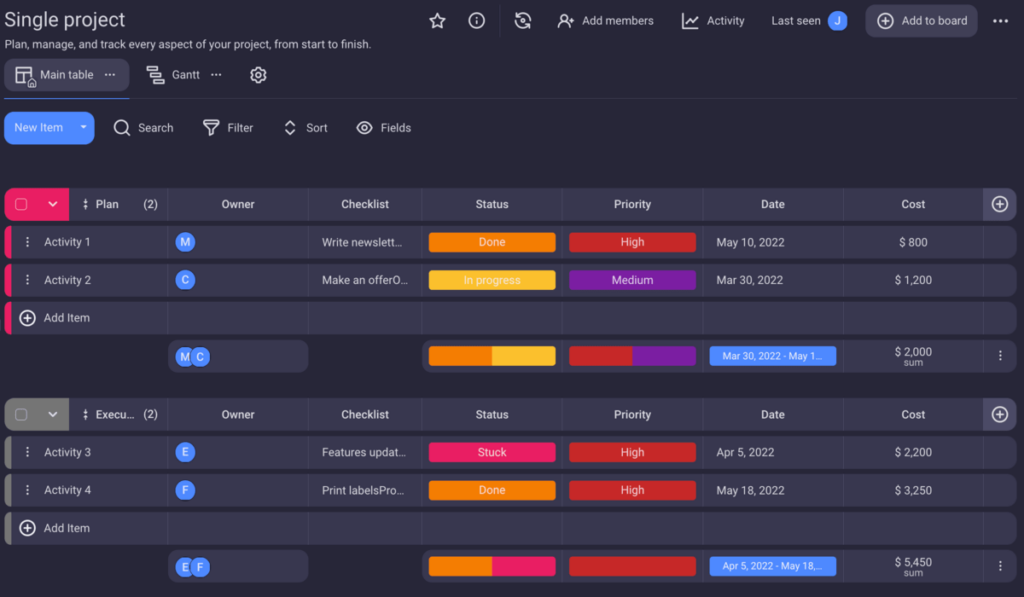
As the name suggests, project management software is a specialized type of software used to facilitate and improve project management. And what does such software look like?
Here, we can take Plaky as an example of a project management tool.
The program allows users to create spaces that house different projects, which in turn provide an overview of individual tasks.
The tasks can be viewed and grouped according to user preference, and they contain all the information relevant to the task, including:
- The name of the task,
- The current status of the task (unassigned, in progress, awaiting review, etc.),
- Assignees and other relevant personnel,
- The completion deadline,
- A detailed description of the task, and more.
Ultimately, what a project management tool does is it:
- Provides all team members with a comprehensive overview of all projects they’re involved in,
- Streamlines workflows and communication, and
- Makes it easier for managers to visualize and implement necessary changes.
💡 Plaky Pro Tip
Project management tools aren’t identical, and each solution has its own unique strengths and weaknesses. For a detailed overview of the latest options, take a look at the following article:
What are the benefits of effective project management?
With all of the above in mind, it need not be said that effective project management can offer businesses many benefits.
If you’re thinking about investing in project management at your company, here are all the benefits you should consider:
- Increased productivity and efficiency,
- Reduced costs,
- Improved collaboration,
- Detailed performance tracking,
- Better risk management, and
- More learning opportunities.
We’ll explain each one in more detail below.
#1 Increased productivity and efficiency
The first and most obvious benefit to implementing effective project management is, quite simply, its immense positive impact on a business’s overall productivity and efficiency in executing individual projects.
When your team knows exactly what they should be doing, when they should be doing it, and what resources they have at their disposal, you can expect productivity and efficiency to increase noticeably.
#2 Reduced costs
Regardless of whether we’re talking about Lean project management or any other methodology, careful planning and implementation of project management processes will always have a positive effect on reducing operational costs for your company.
Implementing an effective strategy means you won’t:
- Overspend on materials,
- Expand your team more than needed,
- Incur extra costs due to complications,
- Lose money due to unforeseen downtimes, and more.
💡Plaky Pro Tip
Interested in learning more about costs and budgets in project management? Take a look at the following articles:
#3 Improved collaboration
Established project management processes are another way to drastically improve communication and collaboration between team members.
It ensures every team member is aware of their responsibilities, has insight into what other team members are doing, and has all the information required to complete their tasks.
Furthermore, it promotes a culture of personal accountability via increasing transparency in the team.
#4 Detailed performance tracking
Using project management techniques allows you to identify important KPIs and reap the benefits of detailed performance tracking — you gain insight into the capacity and efficiency of your team, which in turn lets you optimize workflows and distribute work better.
#5 Better risk management
As mentioned before, unforeseen risks can lead to major setbacks for any project, or even cause it to fail altogether, which can have a negative impact on the company as a whole.
However, implementing a project management methodology can greatly help mitigate risks in a number of ways.
For example, a Waterfall approach gives the project manager time to anticipate and plan for potential risks, while an Agile strategy would make it easier for the team to quickly adapt to changing situations.
💡 Plaky Pro Tip
Want to learn more about risk in project management? Take a look at the article below:
#6 More learning opportunities
There is no project management without a project manager, and bringing an experienced PM on board opens many opportunities for the team to develop new skills and gain project management experience, all the while opening doors to improving processes in the company as a whole.
Project management example: IT industry — website development
Projects differ across different industries — but project management principles remain the same. The ultimate goal is to finish the project successfully, in the planned time, with the use of allocated project resources, and within the specified budget.
Imagine working for a software development company and having a client who wants to hire your company for website development.
First, your managers have to meet with the client, discuss their requirements and create a project proposal with estimated time, resources, and costs.
After the initial proposal, the client may decide to proceed.
Project planning phase
During this phase, a project manager defines the project’s requirements and determines how many people and how much time the website development requires.
The client may provide your team with the ideal project deadline.
The project manager decides on a team that will work on the project, creates a timeline, and defines project milestones.
💡 Plaky Pro Tip
For a more in-depth look at how software projects are planned, check out this article:
Work in progress
After your company starts working on the project, the project manager is the one who:
- Is in charge of communication with the client to deliver progress updates. For instance, the project manager may schedule a weekly meeting with the development team or provide/ask for progress updates via email.
- Executes, monitors, and controls the project as the project team works on the website development. There are various project management techniques project managers can use. Depending on the technique used, the project manager assigns tasks and requires team feedback to monitor the team’s work progress and the quality of work.
The team who works on a project has to track their time with time-tracking software and use project management software which helps a project manager monitor the timeline.
Project closing phase
Once the team finishes website development and your QA team test functionalities, the client reviews it to check if it meets all requirements. After positive feedback, the project closes.
After the project’s finalization, the project manager may hold a meeting to review the work accomplished and get team feedback on communication and project organization in general.
💡 Plaky Pro Tip
For examples of the use of project management in more industries, check out the following guides:
- Sales Project Management Explained (+ Examples & Techniques)
- Creative Project Management: The Definitive Guide
- How to Master Real Estate Project Management (+ Expert Tips)
- Marketing Project Management — A Guide With Expert Insights
- HR Project Management: The Complete Guide
- What Is Enterprise Project Management? (+ Expert Tips on EPM)
Wrapping up: Project management helps reach the project goal
Project management aims to oversee potential problems with a project — as well as plan, organize, and control activities effectively and efficiently in order to close said project successfully.
Making the effort to systematically manage a project enables the better organization of business processes and helps the team working on the project meet the project goal and objectives in an optimal manner.
The organization of any project is far easier with the use of project management software. This allows you to manage and oversee all tasks in one centralized place, providing a clear overview of the project progress. Sign up for Plaky’s free account today and give yourself a bird’s eye view of all project details.
How we reviewed this post: Our writers & editors monitor the posts and update them when new information becomes available, to keep them fresh and relevant.
